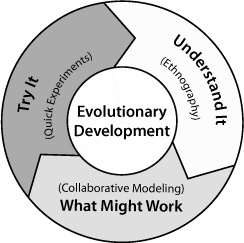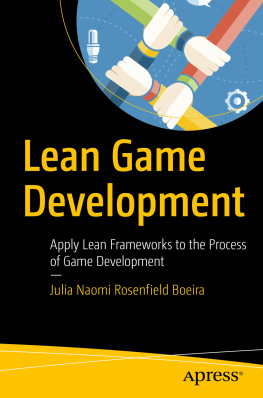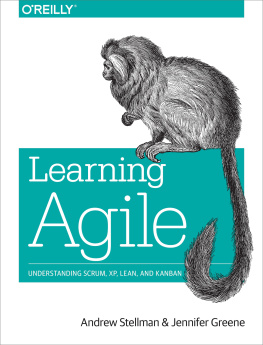Poppendieck MaryPoppendieck Thomas David. - Leading lean software development: results are not the point
Here you can read online Poppendieck MaryPoppendieck Thomas David. - Leading lean software development: results are not the point full text of the book (entire story) in english for free. Download pdf and epub, get meaning, cover and reviews about this ebook. City: Upper Saddle River, year: 2013;2010, publisher: Pearson Education Limited (US titles);Addison-Wesley, genre: Politics. Description of the work, (preface) as well as reviews are available. Best literature library LitArk.com created for fans of good reading and offers a wide selection of genres:
Romance novel
Science fiction
Adventure
Detective
Science
History
Home and family
Prose
Art
Politics
Computer
Non-fiction
Religion
Business
Children
Humor
Choose a favorite category and find really read worthwhile books. Enjoy immersion in the world of imagination, feel the emotions of the characters or learn something new for yourself, make an fascinating discovery.
- Book:Leading lean software development: results are not the point
- Author:
- Publisher:Pearson Education Limited (US titles);Addison-Wesley
- Genre:
- Year:2013;2010
- City:Upper Saddle River
- Rating:4 / 5
- Favourites:Add to favourites
- Your mark:
- 80
- 1
- 2
- 3
- 4
- 5
Leading lean software development: results are not the point: summary, description and annotation
We offer to read an annotation, description, summary or preface (depends on what the author of the book "Leading lean software development: results are not the point" wrote himself). If you haven't found the necessary information about the book — write in the comments, we will try to find it.
Leading lean software development: results are not the point — read online for free the complete book (whole text) full work
Below is the text of the book, divided by pages. System saving the place of the last page read, allows you to conveniently read the book "Leading lean software development: results are not the point" online for free, without having to search again every time where you left off. Put a bookmark, and you can go to the page where you finished reading at any time.
Font size:
Interval:
Bookmark:
Results Are Not the Point

Upper Saddle River, NJ Boston Indianapolis San Francisco
New York Toronto Montreal London Munich Paris Madrid
Capetown Sydney Tokyo Singapore Mexico City
Many of the designations used by manufacturers and sellers to distinguish their products are claimed as trademarks. Where those designations appear in this book, and the publisher was aware of a trademark claim, the designations have been printed with initial capital letters or in all capitals.
The following terms are trademarks or registered trademarks of International Business Machines Corporation in the United States, other countries, or both: Websphere, Websphere Service Registry and Repository, IBM, and the IBM logo.
Capability Maturity Model Integration and SCAMPI are service marks of Carnegie Mellon University.
Post-it is a registered trademark of 3M Company in the United States, other countries, or both.
The authors and publisher have taken care in the preparation of this book, but make no expressed or implied warranty of any kind and assume no responsibility for errors or omissions. No liability is assumed for incidental or consequential damages in connection with or arising out of the use of the information or programs contained herein.
The publisher offers excellent discounts on this book when ordered in quantity for bulk purchases or special sales, which may include electronic versions and/or custom covers and content particular to your business, training goals, marketing focus, and branding interests. For more information, please contact:
U.S. Corporate and Government Sales
(800) 382-3419
corpsales@pearsontechgroup.com
For sales outside the United States please contact:
International Sales
Visit us on the Web: informit.com/aw
Library of Congress Cataloging-in-Publication Data
Poppendieck, Mary.
Leading lean software development : results are not the point / Mary and
Tom Poppendieck.
p. cm.
Includes bibliographical references and index.
ISBN 0-321-62070-4 (pbk. : alk. paper)
1. Management information systems. 2. Computer softwareDevelopment. 3.
Organizational effectiveness. I. Poppendieck, Tom. II. Title.
HD30.213.P65 2010
658.4038011dc22 2009035319
Copyright 2010 Poppendieck LLC
All rights reserved. Printed in the United States of America. This publication is protected by copyright, and permission must be obtained from the publisher prior to any prohibited reproduction, storage in a retrieval system, or transmission in any form or by any means, electronic, mechanical, photocopying, recording, or likewise. For information regarding permissions, write to:
Pearson Education, Inc
Rights and Contracts Department
501 Boylston Street, Suite 900
Boston, MA 02116
Fax (617) 671-3447
ISBN-13: 978-0-321-62070-4
ISBN-10: 0-321-62070-5
Text printed in the United States on recycled paper at RR Donnelly in Crawfordsville, Indiana.
First printing, October 2009.
I was a relative newbie to both agile and lean when I first met Mary and Tom Poppendieck at an Agile Conference in Salt Lake City in 2003, so of course I started our conversation with the question that had been bothering me: How do you reconcile the lean view that tests are waste with the need for tests in software development? Marys immediate response: Unit tests are what let you stop the line.
Ive learned a lot about both agile and lean since then, and the more I learn, the more I appreciate the profound understanding that led to that simple answer so clearly tying multiple agile practices to fundamental lean principles.
So, when Mary asked me to review her new book, I jumped at the chance, and I wasnt disappointed. The approach of framing various views into lean leadership provided fresh perspectives on many of the issues that we must all address if we are to be effective in developing software in the twenty-first century. I could rave on about the book, but that would just keep you from reading it, so I decided to limit myself to sharing my three favorite parts of the book (in chronological order)not an easy task when the whole book is packed with valuable information.
Since Im a geek at heart, my first favorite part of the book was Chapter 2, Technical Excellence, with its fresh look at agile practices as a continuation and extension of the fundamentals expressed in the early days of computer science by giants such as Dijkstra, Parnas, and Mills. Seeing agile practices as an evolution of the best of the past, rather than as a revolution that rejects the past, is an important step in enabling adoption of the best that agile has to offer.
Since Im an idealist, my second favorite part of the book was in Chapter 4, Relentless Improvement, with the discussion of the need for a shared vision of what success will look like for your organization. When you couple this with the material in the same chapter about the importance of managers as mentors in developing problem solvers, you start to see the potential for an organization where everyone works every day to remove the impediments to future success.
Finally, since Im a realist, my third favorite part of the book was Chapter 5, Great People. Success comes from people. Results are not the point. Developing people so that they can achieve successful results is the point. Statistically speaking, no large company has all above-average employees, suppliers, and customers. However, by following the principles and advice in this book, any company, large or small, has the potential of getting above-average results from its average employees, suppliers, and customers. Thats really what business success is all about.
If I read the book again, would I pick the same three favorite parts? I dont know, but Ill find out. As soon as the book is published, Ill be starting book clubs across our company to share these ideas and see where they lead us. I encourage all of you to do the same.
Dottie Acton
Senior Fellow
Lockheed Martin
Swedens Handelsbanken has placed a large sum of money in an account at the Riksbank in a bid to help the central bank safeguard the financial system.
Stockholm, June 17, 2009 (Reuters)
Svenska Handelsbanken is one of the top 25 banks in Europe. It was not just the only bank that survived the Swedish banking crisis in the 1990s without asking for government supportit has also done very well in the 2008/2009 crisis. Handelsbanken did not have to raise capital or ask for government support and its shares have been the best performing European bank stock by a wide margin. Despite its large size Handelsbanken has, in many ways, acted as a shock absorber, not a shock amplifier, to the financial system.
In 1970, Svenska Handelsbanken was 100 years old and deeply troubled. It was trying mightily to become the largest bank in Sweden, and costs had gotten out of control. To make a bad situation worse, a small provincial bank in northern Sweden was eating into its market share. When the Handelsbanken management team abruptly resigned, its board decided to recruit the head of the upstart competitor as Handelsbankens new managing director. Dr. Jan Wallander was a professional economist turned banker who had his own ideas about how to run a bank.
The first thing Wallander did was to make it clear that growth is not the point; profitability is what matters. He insisted that everyone in the bank stop trying to bring in as much revenue as possible and start focusing on generating profitable revenue instead. To accomplish this goal, he had information systems publish a few key metrics for each branch immediately after the end of each month, numbers such as the cost-to-income ratio (the inverse of profitability) and income per employee (productivity). Then he gave branch managers the freedom to manage their affairs locally. They could decide which products to sell, how much money to spend, how many employees to hire, and so on. Wallander felt that central control got in the way of the people closest to customers, slowed down their reaction time, and stifled their creativity. So decision-making authority devolved to branch managers; staff groups were dramatically reduced in number and size, and those that remained had to sell their services to the branches.
Font size:
Interval:
Bookmark:
Similar books «Leading lean software development: results are not the point»
Look at similar books to Leading lean software development: results are not the point. We have selected literature similar in name and meaning in the hope of providing readers with more options to find new, interesting, not yet read works.
Discussion, reviews of the book Leading lean software development: results are not the point and just readers' own opinions. Leave your comments, write what you think about the work, its meaning or the main characters. Specify what exactly you liked and what you didn't like, and why you think so.






